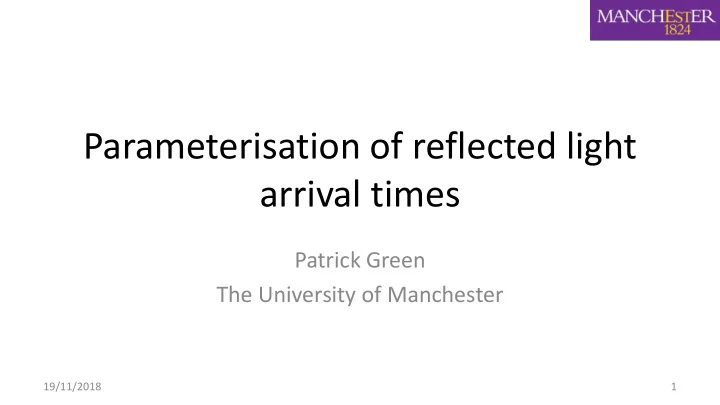

Parameterisation of reflected light arrival times Patrick Green The University of Manchester 19/11/2018 1
Introduction • As previously shown by Diego, the Landau + Exponential parameterisation of VUV arrival times is very effective. • With the inclusion of TPB coated reflective foils an equivalent parameterisation for the reflected light is required. • Aim: to use the distribution from the VUV parameterisation to predict the reflected light distribution. • The fastest path taken by the reflected light can be calculated, then the arrival time distribution can be approximated by smearing the VUV distribution along this path. Diego Garcia-Gamez 19/11/2018 Patrick Green 2
Fastest arrival time Image Hotspot • Hotspot is the point on the Reflection Cathode cathode most strongly illuminated 𝑒 ∗ 𝑜 𝑤𝑗𝑡 point 𝑜 𝑤𝑣𝑤 by the scintillation. • Image is reflection about cathode 𝜄 plane weighed by refractive Visible path 𝑒 indices of each component in LAr. * • VUV path Intercept of line between image and detector with the cathode 𝛽 Scintillation point plane gives the reflection point of the fastest path. Arapuca 19/11/2018 Patrick Green 3
Fastest arrival time Image Hotspot • Time taken by VUV part of path Reflection Cathode 𝑒 ∗ 𝑜 𝑤𝑗𝑡 given by Landau + Exponential point 𝑜 𝑤𝑣𝑤 parameterisation. • Time taken by visible part of path 𝜄 Visible path 𝑒 calculated by the distance divided by the velocity since Rayleigh * VUV path scattering negligible. 𝛽 Scintillation point Arapuca 19/11/2018 Patrick Green 4
Fastest arrival time d = 160cm, θ = 0 ° , α = 0 ° • Fastest arrival time matches Full simulation full optical simulation to Parameterisation within 1-2ns. • However, distribution of arrival times inaccurate. • Detected photons arrive from area around the fastest path reflection point. 19/11/2018 Patrick Green 5
Distribution of arrival times Image Hotspot • Distribution approximated by Reflection Cathode smearing the arrival times found 𝑒 ∗ 𝑜 𝑤𝑗𝑡 point 𝑜 𝑤𝑣𝑤 from the fastest path: 𝑢 𝑡 = 𝑢 + 𝑢 − 𝑢 𝑔 ∗ [exp −𝜐 ∗ ln 𝑦 − 1] 𝜄 Visible path 𝑒 where 𝑦 = 𝑠𝑏𝑜𝑒[0.5, 1 − 𝜀] . * VUV path • 𝜐 and 𝜀 parameterised in terms of 𝑒 𝛽 Scintillation point and 𝜄 using simple minimisation method. Arapuca 19/11/2018 Patrick Green 6
Distribution of arrival times • 𝜐 and 𝜀 found using a simple minimisation method. 𝜐 fit 𝜀 fit 19/11/2018 Patrick Green 7
Smearing: d = 160cm, θ = 0 ° , α = 0 ° Un-smeared Smeared Full simulation Full simulation Parameterisation Parameterisation 19/11/2018 Patrick Green 8
Smearing: d = 160cm, θ = 13.9 ° , α = 49.3 ° Un-smeared Smeared Full simulation Full simulation Parameterisation Parameterisation 19/11/2018 Patrick Green 9
Smearing: d = 160cm, θ = 26.3 ° , α = 66.7 ° Un-smeared Smeared Full simulation Full simulation Parameterisation Parameterisation 19/11/2018 Patrick Green 10
Smeared distributions: d = 60cm θ = 0 ° , α = 0 ° θ = 28.9 ° , α = 57.2 ° Full simulation Full simulation Parameterisation Parameterisation 19/11/2018 Patrick Green 11
Smeared distributions: d = 260cm θ = 0 ° , α = 0 ° θ = 24.1, α = 77.9 ° Full simulation Full simulation Parameterisation Parameterisation 19/11/2018 Patrick Green 12
Summary • Can calculate the earliest reflected light arrival time to within 1-2ns by calculating the fastest path accounting for the differing refractive indices of VUV and visible light in LAr. • The distribution of the arrival times can then be approximated by smearing the times calculated along fastest path with an exponential distribution. • Approximation works well, although some discrepancy at large angles. However, these cases are minority of detected photons. • The next stage is implementation into LArSoft. 19/11/2018 Patrick Green 13
Back-up 19/11/2018 Patrick Green 14
Distribution of arrival times Image Hotspot • Used a simple minimisation Reflection Cathode technique obtain values of 𝜐 and 𝜀 . 𝑒 ∗ 𝑜 𝑤𝑗𝑡 point 𝑜 𝑤𝑣𝑤 • Parameterisation of 𝜐 : 𝜐 = 12.30 − 0.114 𝑒 + 4.54 × 10 −4 𝑒 2 𝜄 Visible path 𝑒 − 6.20 × 10 −7 𝑒 3 * VUV path • Parameterisation of 𝜀 : 𝛽 𝜀 = 3.17 × 10 −3 + 5.20 × 10 −6 𝑒 Scintillation point + 2.21 × 10 −8 𝑒 2 ∗ 𝜄 Arapuca 19/11/2018 Patrick Green 15
Recommend
More recommend